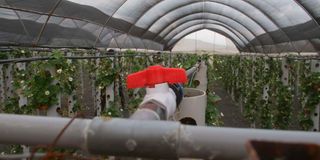How to clean and maintain drip irrigation system

The drip irrigation system at Sangare farm in Nyeri county. While efficiently maintaining the drip lines during the crop production cycle, they can be used for close to two years.
Once the crop production cycle is over, farmers always look forward to the next season.
This includes planning for what crop they can grow next and how they will prepare the land and buy various inputs.
One of the things, however, many ignore to check is the irrigation system. You need to keep the tanks and drip lines in good shape so that they can serve you well in the next production cycle.
It all starts during the production period by ensuring the entire irrigation system is not damaged. Ideally, flushing the system with water at least three times during the crop production cycle helps dislodge smaller obstructions and prevents clogs from forming in the pipes.
This guarantees efficient water flow, reducing the amount of water the crop receives.
In the case of the drip irrigation system, once the crop cycle is over, the drip lines should be properly removed to enable land preparation. This also prevents the chances of damaging the irrigation system. To remove the lines, loosen the end cap and move the drip lines towards the mainline.
Once the land preparation is complete, align the drip lines on the bed with the emitter facing upwards. In some cases, especially while using salty water, the drip lines tend to clog due to salt accumulation. The soil particles also clog the lines preventing efficient water flow.
The drip lines should be appropriately cleaned before using them in the next crop cycle for production purposes. To flush the drip lines, open the end cap and open the water under high pressure.
Acids
You can also consider using acids such as nitric and hypochloric. The acid reduces clogging caused by low-solubility salts in water, such as calcium carbonate.
If you don't have a fertigation system, you can mix the water and acid in a bucket, use a venturi, turn up the pump, and run the irrigation system. The mixture should be released across the entire system. After this, the drip lines should be thoroughly flushed. This should be repeated until the system is unblocked.
When using acid, wear personal protective gear, which includes gumboots, goggles and gloves to protect yourself.
The blocked emitters can also be cleaned by tapping lightly with a small stick and wiping while the water is running in the system.
The lateral lines should also be flushed to remove debris that accumulates and clogs the drip lines. This is usually done by opening the lateral end for one minute until the water coming out is clear.
Farmers should make sure that the water they use for irrigation is clean and doesn't have any particles. Particles clog up the system. For good results, one should also consider using drip lines with high water flow. A flow rate of 1.6 litres per hour reduces the blockages.
Using a removable end cap on the end of the drip lines makes it easier to flush the lines and keep salt from building up during the crop production cycle.
While efficiently maintaining the drip lines during the crop production cycle, they can be used for close to two years.





